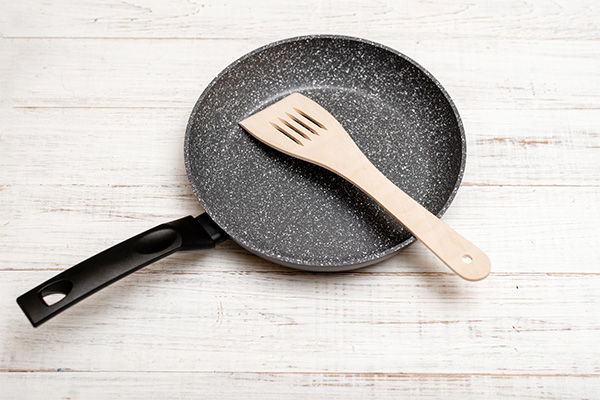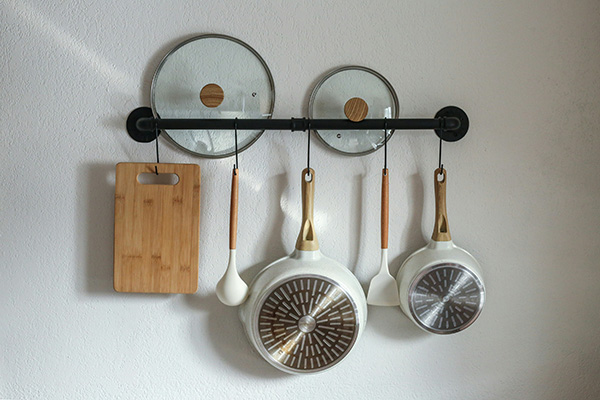In the ever-evolving world of kitchenware, ceramic cookware has been making waves as a healthier alternative to traditional non-stick pans and pots. With its natural appeal, non-stick capabilities, and promise of chemical-free cooking, ceramic cookware has captured the attention of health-conscious chefs and home cooks alike.
But amidst all the buzz, the question remains: Is ceramic cookware safe? Keep reading to learn more about ceramic cookware and whether it is the right type of non-stick cookware for you!
What Is Ceramic Cookware?
Ceramic cookware refers to a type of cookware that is made primarily from ceramic materials. In recent years, ceramic cookware has become increasingly popular as an alternative to traditional non-stick cookware. It's valued for its non-stick properties and perceived health advantages, standing in contrast to traditional non-stick pans that frequently incorporate chemicals like PTFE (polytetrafluoroethylene) and PFOA (perfluorooctanoic acid). These chemicals can potentially emit harmful fumes when exposed to high temperatures.
Ceramic cookware can be categorized into two main types. The first type, known as pure ceramic cookware, is crafted from a combination of clay and quartz sand. It is still available to purchase, although it is becoming harder to find. Most ceramic cookware brands produce ceramic-coated cookware instead. This cookware consists of a metal base (typically aluminum) covered with a ceramic coating. This ceramic glaze is made from a special sand-derived silica called "sol-gel." This coating is bonded to the metal and releases a nonstick silicone oil when the pan is heated.
Is Non-Stick Ceramic Cookware Safe To Use?

The answer isn't straightforward. While ceramic cookware is generally safer than traditional non-stick cookware, there are some potential safety concerns that you should be aware of.
Ceramic cookware is typically considered safe for cooking when used and maintained correctly. It's certainly better compared to traditional non-stick cookware, such as Teflon cookware, as it doesn't contain PTFE (polytetrafluoroethylene) and PFOA (perfluorooctanoic acid).
The non-stick surface of ceramic-coated cookware allows for cooking with less oil or fat, which can be a health benefit. However, it's essential to follow proper care and maintenance instructions to maintain the integrity of the non-stick surface and avoid the risk of flaking or chipping, which could potentially end up in your food.
In some cases, especially with cheaper or lower-quality ceramic cookware, there have been concerns about the potential presence of lead and cadmium in the glaze or decorative coatings. To ensure safety, it's best to choose cookware tested and certified as lead and cadmium-free.
The safety of ceramic cookware can fluctuate based on the brand and product quality. It is important to opt for well-established brands with a reputation for quality and safety standards. Prioritize brands and products with clear labels indicating they are free from lead and cadmium. Furthermore, cookware that adheres to safety certifications and provides third-party testing reports should be considered to ensure peace of mind.
Ceramic Coated Cookware Vs. Traditional Non-Stick Cookware
Material
When it comes to material, ceramic-coated cookware features a cooking surface that is coated with a layer of ceramic, often infused with minerals like titanium or diamond, for added durability.
Ceramic coatings do not release toxic fumes or leach toxic chemicals, including PFAS when heated to high temperatures. In this respect, ceramic-coated pans are safer than other cookware options. However, some ceramic coatings may wear out over time, so following proper care instructions is important.
Traditional non-stick cookware is often made with a cooking surface coated with PTFE (commonly known as Teflon) or a similar synthetic non-stick material. The concern with Teflon and other non-stick pans is that the coatings have been proven to release toxic chemicals when heated to high temperatures. These chemicals, known as PFOAs, cause significant health risks to humans.
Although PFOAs have been globally banned since 2019, other materials, such as PFAS, are released from this type of coating when heated. Research is ongoing on these compounds and their potential health risks, and many people have determined that it's not worth the risk when healthy cookware options are available.
Non-Stick Properties
Like enameled cast iron, the ceramic, non-stick coating makes cooking easier with less oil or fat. Food tends to slide off the surface with minimal sticking. At the same time, traditional non-stick cookware surfaces are highly effective at preventing food from sticking to the surface. It is known for its exceptional non-stick performance.
Durability
The longevity of ceramic coatings can fluctuate based on the coating's quality and the level of maintenance it receives. If not handled with care, certain ceramic-coated pans may be susceptible to chipping or scratching. It's worth noting that most ceramic-coated cookware isn't suitable for use with metal utensils; instead, it's advisable to opt for utensils made of wood or silicone to preserve the coating's integrity.
Traditional non-stick coatings can wear out over time, especially if scratched or damaged. They may need to be replaced periodically.
Heat Resistance
Ceramic-coated cookware is generally safe for moderate to high temperatures, but avoiding extreme temperature changes is essential to prevent thermal shock.
Conventional non-stick coatings are typically not recommended for high-heat cooking techniques like searing or broiling since they can degrade when exposed to elevated temperatures.
Maintenance
Ceramic-coated cookware typically requires gentle hand washing with mild detergent and non-abrasive cleaning tools to prolong the life of the coating. Abrasive scrubbers and dishwasher use can degrade the ceramic coating. Traditional nonstick cookware is relatively easy to clean but should also be hand-washed with non-abrasive materials. Dishwasher use and the use of metal utensils can damage the non-stick coating.
Benefits Of Ceramic Coated Cookware

Non-Stick Surface
The coating on ceramic pans and pots is made from silica and releases a small amount of silicone oil when heated. Silicone is naturally non-stick and produces a fantastic non-stick cooking surface. Although this silicone oil will gradually lessen and get used up as time goes on, the ceramic coating completely eliminates the need for any cooking oil for as long as the silicone oil is present. Using less cooking oil during food preparation is a great step towards healthy living!
Easy To Clean
The non-stick characteristics of ceramic cookware simplify the cleaning process. Because dishwashers reach high temperatures, it's advisable to clean ceramic-coated cookware by hand in the sink, using warm water and mild soap. Otherwise, you may significantly reduce the amount of silicone oil in the coating every time you put the pan in the dishwasher!
Environmentally Friendly
Because ceramic coatings do not contain PTFE or PFOA, they are considered more environmentally friendly than traditional non-stick coatings, which can release harmful chemicals into the environment during production and use.
Even Heat Distribution
Ceramic-coated pots and pans typically ensure even heat distribution, preventing hot spots and ensuring uniform dish cooking. This can result in better cooking results and reduced risk of overcooking or undercooking.
Stylish Design
Unlike other cookware like stainless steel or cast iron, ceramic-coated pots and pans often feature attractive and colorful exteriors, making them aesthetically pleasing and a great addition to your kitchen.
Moderate Heat Resistance
Like stainless steel pots and pans, ceramic-coated cookware can handle moderate to high cooking temperatures, making it suitable for various cooking methods, including sautéing, frying, simmering, and baking.
Durable Construction
High-quality ceramic-coated cookware can be quite durable when cared for properly. Adding minerals like titanium or diamond to the ceramic coating can enhance its durability and scratch resistance.
Food Safety
Ceramic cookware itself is generally safe for cooking food. It does not react with acidic or alkaline ingredients, which can be a concern with some other types of cookware, like aluminum or cast iron. However, scratched ceramic and nonstick pans can be harmful to your health.
Concerns With Ceramic Coated Cookware

May Contain Lead
While most new cookware produced by ceramic cookware manufacturers is free of lead and other heavy metals, vintage ceramic cookware tests very high in lead content, although older ceramic cookware is more likely to be pure ceramic rather than coated metal, it is not safe due to its highly toxic lead content.
Uneven Heat Distribution
Although the surface of ceramic-coated cookware appears smooth and glossy, the irregularity of the spacing of the silicone particles means that the cooking surface is actually uneven and rough once heat is applied. This will prevent food from directly contacting the pan's surface and make cooking difficult.
Less Durable
Because the silicone oil in the ceramic coating eventually dissipates, ceramic cookware has a much shorter lifespan than other types of non-toxic cookware options. This coating also renders ceramic cookware not dishwasher-safe, oven-safe, or safe for metal utensils.
Furthermore, although high-quality cookware brands produce ceramic cookware with a dense metal base, most ceramic pots and pans are not made with cladded metal and are likely to warp over time.
Food Sticking Over Time
Although ceramic cookware starts with excellent non-stick properties, the coating can lose some of its effectiveness over time. Proper care and maintenance are necessary to extend its non-stick performance.
Staining
While the ceramic coating is resistant to staining, certain foods or cooking processes (e.g., tomato-based sauces) can cause discoloration over time. Regular cleaning and proper care can help minimize staining.
Lead
Lead, a heavy metal, poses significant health risks, particularly when ingested or inhaled. It is a well-established neurotoxin capable of causing a variety of health issues, with heightened concerns for children and expectant mothers.
Concern arises in ceramic cookware from glazes or decorative coatings that may contain lead. When searching for ceramic-coated cookware, selecting products certified as being free from lead is essential. Reputable manufacturers should test their products to ensure they meet safety standards and do not leach lead into food during cooking.
Cadmium
Cadmium is another heavy metal found in some ceramic glazes, especially in lower-quality or less-regulated products. Similar to lead, exposure to cadmium can result in detrimental health consequences, such as kidney and bone damage.
Therefore, just like with lead, it's vital to opt for ceramic cookware free of cadmium. Seek out products that have undergone testing and certification to ensure their safety for cooking.
Nanoparticles Of Silicon
The main health concern regarding ceramic cookware is that, although it is generally free of the toxic chemicals found in other cookware options, little research has been done on the safety aspects of the sol-gel coating.
Some ceramic cookware manufacturers use silicon dioxide (silica) nanoparticles to produce their non-stick coatings. These nanoparticles can provide additional durability and non-stick properties to the ceramic surface. While silicon dioxide is generally considered safe, there have been debates and studies about the potential risks associated with nanoparticles.
The concern is that very small particles may have different properties and behavior than larger particles of the same material. It is not yet known if ingesting small amounts of silicone oil is harmful to the human body. Over time, the concerns of silicon nanoparticles building up in the body have led some to consider other non-toxic cookware, such as cast iron, carbon steel, stainless steel, and glass cookware.
